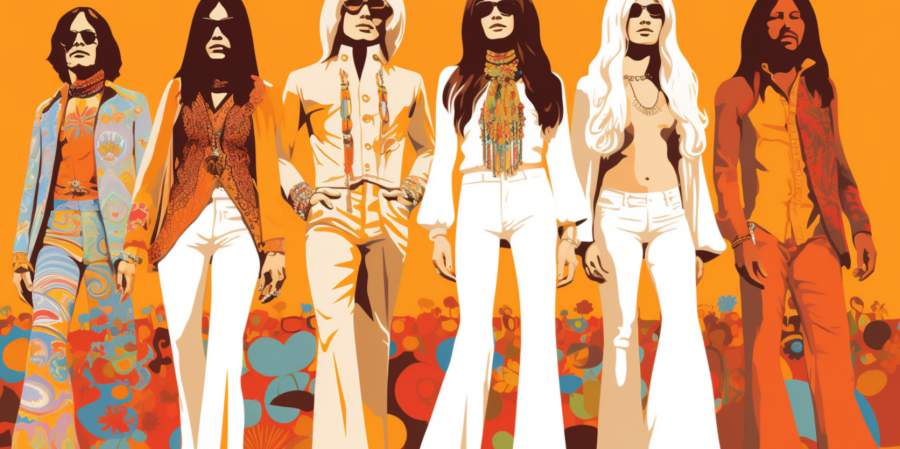Bell Bottoms and Peace: 1960s San Francisco Hippie Movement

An Introduction to the Counterculture Revolution
In the swinging sixties, amidst the turmoil of the Vietnam War and the struggle for civil rights, a ragtag group of free-spirited, flower-wielding, and bell-bottom-wearing individuals emerged in San Francisco. These fascinating characters, known as hippies, sought to challenge the established norms and replace them with their own vision of peace, love, and understanding. The Haight-Ashbury district became their Mecca, a sanctuary for those who sought to escape the suffocating grip of conformity and embrace a new way of life.A Look at the Radical Fashion Choices
One cannot discuss the 1960s San Francisco Hippie Movement without mentioning the iconic fashion that defined the era. Bell bottoms, those glorious, wide-legged trousers that flared out from the knee, were all the rage. It was as if the normal constraints of legwear had been tossed to the wind, giving one's calves and ankles the freedom to breathe and sway in the breeze like a pair of triumphant flags. The more extravagant the design, the better; patchwork patterns, psychedelic swirls, and bold, eye-catching colors were all part of the hippie fashion repertoire.But it wasn't just the pants that made a statement. Flowing tunics, fringed vests, tie-dye shirts, and an abundance of beads were all part of the countercultural uniform. Hair was worn long and unkempt, as if it had been lovingly styled by Mother Nature herself. Men and women alike sported facial hair that would make any lumberjack green with envy. The look was a visual representation of the movement's values: a rejection of materialism, an embrace of nature, and a desire for individual expression.
Music as the Soundtrack of the Revolution
Music played an integral role in the 1960s San Francisco Hippie Movement, becoming the harmonious glue that held the counterculture together. Bands like Jefferson Airplane, The Grateful Dead, and Big Brother and the Holding Company provided a soundtrack for the revolution, their lyrics echoing the frustrations and aspirations of a generation yearning for change. Whether it was a small gathering in Golden Gate Park or the legendary Summer of Love concert, these performances were an opportunity for like-minded souls to come together, dance, and share in the collective experience.It wasn't just the bands themselves that made the music scene such a vital part of the movement. The venues where these performances took place were equally as important. The Fillmore Auditorium and the Avalon Ballroom hosted countless legendary shows, providing a space for both established acts and up-and-coming talent to showcase their skills. Music, be it rock, folk, or the burgeoning genre of psychedelic, became an outlet for self-expression and a vehicle for spreading the message of love and peace.
Experimentation and the Quest for Enlightenment
For many in the 1960s San Francisco Hippie Movement, the search for enlightenment led them to experiment with mind-altering substances. While not everyone partook in this particular aspect of the counterculture, it's impossible to deny the influence that these substances had on the movement. The use of marijuana and hallucinogens like LSD was seen by some as a means to expand their consciousness and explore new realms of thought.Advocates for this type of experimentation believed that it could lead to a greater understanding of oneself and the world around them. They saw these substances as tools to help break down barriers and foster a sense of unity among people. While it's debatable if such lofty goals were ever truly achieved, the impact on the arts, culture, and the overall atmosphere of the time is undeniable.
The Legacy of the 1960s San Francisco Hippie Movement
As the decade drew to a close, the utopian dreams of the Haight-Ashbury community began to unravel. The once-idyllic neighborhood became plagued by overcrowding, rampant drug use, and an influx of opportunists seeking to exploit the counterculture for financial gain. Many of the original pioneers of the movement moved on, seeking new horizons or simply trying to escape the decay that had befallen their beloved home.And yet, despite its decline, the legacy of the 1960s San Francisco Hippie Movement lives on. The changes they helped to usher in, from the advancement of civil rights to the push for environmental awareness, can still be felt today. Their influence on art, music, and fashion remains undeniable, with many contemporary artists and designers drawing inspiration from the countercultural spirit of the time. And perhaps most importantly, the ideals of peace, love, and understanding continue to resonate, serving as a guiding light for those who seek to make the world a better place.
Article kindly provided by foreverinfashion.org
Latest Articles
- Style That Works With Your Body, Not Against It
- Fashion Tourism on Wheels: Curated Shopping Routes Led by Chauffeur Guides
- The Charm of Certainty in a World of Indecision
- Can an Everyday T-Shirt Be Turned into a Modern Heirloom?
- Color, Ceremony, and the Psychology of Celebration
- Styling Graphic T-Shirts for Different Body Types
- Getting Kids to Wear Their Hats Without a Bribe or a Meltdown
- Mastering the Art of Being the Unnoticed Photographer
- Quiet Sportswear Moves Loudly
- Fashion's Most Misunderstood Color Is Brown
- Weight Matters When Cotton Gets Real
- SKU's Out for Summer: Why Your Warehouse Is Melting Down
- Ink as Accessory - How Tattoos Are Replacing Jewelry in Modern Style
- Decoding the Y2K Aesthetic with Style and Sanity
- Accessories
- Jewellery
- Footwear
- Skirts and Dresses
- Shirts and Blouses
- Beauty and Makeup
- Fashion Photography
- Sustainable Fashion
- Street Style
- Fashion History
- Fashion Business
- Fashion Styling
- Fashion Events
- Plus-Size Fashion
- Men's Fashion
- Women's Fashion
- Fashion Blogging
- Fashion Trends
- Fashion Retailers
- Fashion Tips and Advice
- Fashion Business Startups
- Fashion Around the World
- Lingerie
- Sportswear
- Weddings

